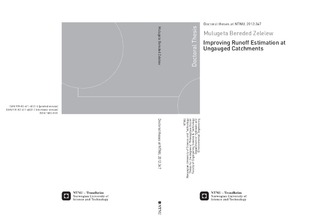| dc.contributor.advisor | Alfredsen, Knut | nb_NO |
| dc.contributor.author | Zelelew, Mulugeta | nb_NO |
| dc.date.accessioned | 2014-12-19T12:32:27Z | |
| dc.date.available | 2014-12-19T12:32:27Z | |
| dc.date.created | 2012-12-13 | nb_NO |
| dc.date.issued | 2012 | nb_NO |
| dc.identifier | 576711 | nb_NO |
| dc.identifier.uri | http://hdl.handle.net/11250/242347 | |
| dc.description.abstract | Water infrastructures have been implemented to support the vital activities of human society. The infrastructure developments at the same time have interrupted the natural catchment response characteristics, challenging society to implement effective water resources planning and management strategies. The Telemark area in southern Norway has seen a large number of water infrastructure developments, particularly hydropower, over more than a century. Recent developments in decision support tools for flood control and reservoir operation has raised the need to compute inflows from local catchments, most of which are regulated or have no observed data. This has contributed for the motivation of this PhD thesis work, with an aim of improving runoff estimation at ungauged catchments, and the research results are presented in four manuscript scientific papers.
The inverse distance weighting, inverse distance squared weighting, ordinary kriging, universal kriging and kriging with external drift were applied to analyse precipitation variability and estimate daily precipitation in the study area. The geostatistical based univariate and multivariate map-correlation concepts were applied to analyse and physically understand regional hydrological response patterns. The Sobol variance based sensitivity analysis (VBSA) method was used to investigate the HBV hydrological model parameterization significances on the model response variations and evaluate the model’s reliability as a prediction tool. The HBV hydrological model space transferability into ungauged catchments was also studied.
The analyses results showed that the inverse distance weighting variants are the preferred spatial data interpolation methods in areas where relatively dense precipitation station network can be found. In mountainous areas and in areas where the precipitation station network is relatively sparse, the kriging variants are the preferred methods. The regional hydrological response correlation analyses suggested that geographic proximity alone cannot explain the entire hydrological response correlations in the study area. Besides, when the multivariate map-correlation analysis was applied, two distinct regional hydrological response patterns - the radial and elliptical-types were identified. The presence of these hydrological response patterns influenced the location of the best-correlated reference streamgauges to the ungauged catchments. As a result, the nearest streamgauge was found the best-correlated in areas where the radial-type hydrological response pattern is the dominant. In area where the elliptical-type hydrological response pattern is the dominant, the nearest reference streamgauge was not necessarily the best-correlated. The VBSA verified that varying up to a minimum of four to six influential HBV model parameters can sufficiently simulate the catchments' responses characteristics when emphasis is given to fit the high flows. Varying up to a minimum of six influential model parameters is necessary to sufficiently simulate the catchments’ responses and maintain the model performance when emphasis is given to fit the low flows. However, varying more than nine out of the fifteen HBV model parameters will not make any significant change on the model performance.
The hydrological model space transfer study indicated that estimation of representative runoff at ungauged catchments cannot be guaranteed by transferring model parameter sets from a single donor catchment. On the other hand, applying the ensemble based model space transferring approach and utilizing model parameter sets from multiple donor catchments improved the model performance at the ungauged catchments. The result also suggested that high model performance can be achieved by integrating model parameter sets from two to six donor catchments. Objectively minimizing the HBV model parametric dimensionality and only sampling the sensitive model parameters, maintained the model performance and limited the model prediction uncertainty. | nb_NO |
| dc.language | eng | nb_NO |
| dc.publisher | NTNU | nb_NO |
| dc.relation.ispartofseries | Doctoral Theses at NTNU, 1503-8181; 2012:347 | nb_NO |
| dc.subject | ensemble modelling | en_GB |
| dc.subject | geostatistics | en_GB |
| dc.subject | generalised sensitivity analysis | en_GB |
| dc.subject | HBV hydrological model | en_GB |
| dc.subject | hydrological regionalisation | en_GB |
| dc.subject | multivariate map-correlation | en_GB |
| dc.subject | precipitation variability analysis | en_GB |
| dc.subject | prediction uncertainty | en_GB |
| dc.subject | sensitivity analysis | en_GB |
| dc.subject | Sobol’s method | en_GB |
| dc.subject | variance based sensitivity analysis | en_GB |
| dc.subject | ungauged catchments | en_GB |
| dc.subject | univariate map-correlation | en_GB |
| dc.title | Improving Runoff Estimation at Ungauged Catchments | nb_NO |
| dc.type | Doctoral thesis | nb_NO |
| dc.source.pagenumber | 56 | nb_NO |
| dc.contributor.department | Norges teknisk-naturvitenskapelige universitet, Fakultet for ingeniørvitenskap og teknologi, Institutt for vann- og miljøteknikk | nb_NO |
| dc.description.degree | PhD i vann- og miljøteknikk | nb_NO |
| dc.description.degree | PhD in Hydraulic and Environmental Engineering | en_GB |

